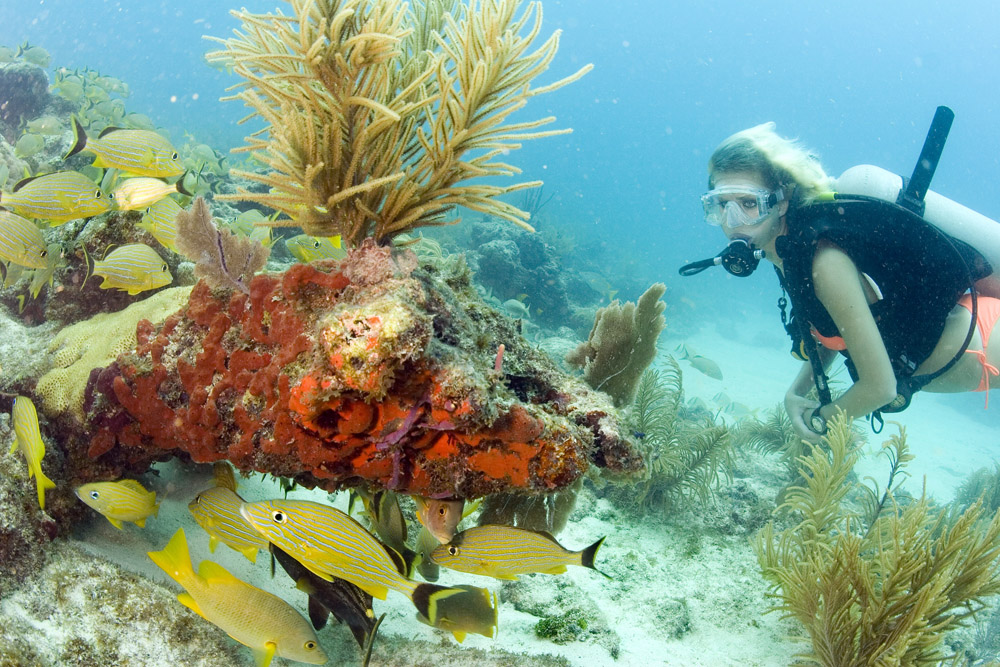Thousands of scuba divers, snorkelers, fishing fans and watersports enthusiasts visit the Florida Keys annually to dive or snorkel the continental United States’ only living coral reef and enjoy Keys waters.
In November 2015, the Florida Keys National Marine Sanctuary marks 25 years of dedication to protecting the world’s third-largest barrier reef — and the waters surrounding the entire island chain.

The Florida Keys National Marine Sanctuary includes the waters surrounding the entire Keys island chain. (Photo by Andy Newman, Florida Keys News Bureau)
Administered by the National Oceanic and Atmospheric Administration, the sanctuary is jointly managed with the state of Florida. It became one of 14 marine protected areas in the National Marine Sanctuary System when it was established in November 1990.
“At the time it was the largest national marine sanctuary established in our entire system, and the first sanctuary to be designated by Congress,” said Billy Causey, the Southeast Regional Director for NOAA’s Office of National Marine Sanctuaries.
Today the sanctuary protects 2,900 square nautical miles of waters. Its boundaries stretch from Biscayne National Park near Miami all the way to the Dry Tortugas, 70 miles west of Key West — and it includes vast areas of Florida Bay, the Gulf of Mexico and the Atlantic Ocean.
What lies within the sanctuary’s boundaries? Wonders including spectacular, nationally significant marine resources, historic shipwrecks and other archeological treasures, extensive seagrass beds, mangrove-fringed islands and more than 6,000 species of marine life.

Divers examine the intentionally scuttled 327-foot former U.S. Coast Guard cutter Duane, one of the vessels on the Florida Keys Shipwreck Trail. (Photo by Stephen Frink, Florida Keys News Bureau)
The shipwrecks, FYI, are truly astonishing. The sanctuary is home to the one-of-a-kind Florida Keys Shipwreck Trail, a line of wrecksites from Key Largo to Key West. The trail spotlights centuries-old wrecks, including a Spanish vessel from the 1700s, plus modern cargo and military ships that were intentionally sunk to create artificial reefs.
As well as encouraging an appreciation and understanding of the Keys’ maritime heritage, the trail provides intriguing exploration (both real and virtual) for snorkelers, divers, history buffs and those passionate about the undersea realm.
The sanctuary has proven to be a positive force in attracting eco-conscious visitors to the Florida Keys. Since its establishment, vacationers have become much more aware that the destination cares deeply about the environment.
Visitors to sanctuary waters can experience the many recreational activities this amazing ecosystem offers — including world-class diving, swimming, snorkeling, fishing, kayaking, boating, dolphin-watching and paddleboarding. And the rules and regulations in place ensure that these activities aren’t harmful to the Keys’ natural resources.

Paddle a kayak through the backcountry waters of the Florida Keys, and you’ll see one of the world’s most diverse marine life ecosystems. (Photo by Bob Krist, Florida Keys News Bureau)
Let’s face it — preserving the Keys’ reef and water-based environment is a top priority for a good reason: there’s no more versatile marine destination in the world than the Florida Keys.
“What’s important is that everyone coming down here is coming to a special place with special resources that are protected and managed for their livelihoods,” explained Billy Causey. “We see our role as working with tourism, working with the scientists, working with environmental groups to make sure that those resources are here for the future health and enjoyment of the public in the Florida Keys.”
Join the Florida Keys National Marine Sanctuary’s 25th “birthday” celebration by immersing yourself in the Keys’ vibrant underwater world, experiencing the thrill of catch-and-release sportfishing, paddleboarding, kitesurfing, kayaking — or just savoring the sun and turquoise waters.

